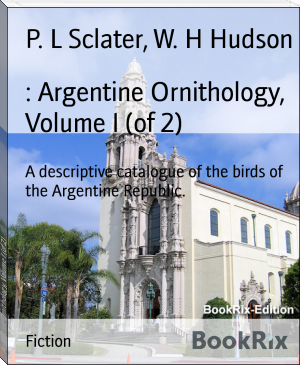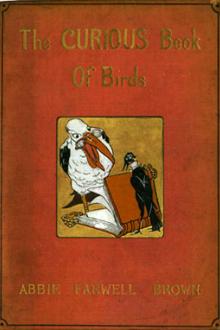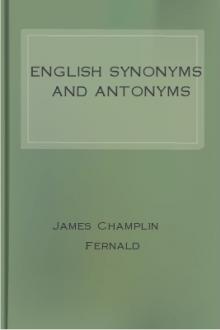: Argentine Ornithology, Volume I (of 2), P. L Sclater, W. H Hudson [best authors to read txt] 📗

- Author: P. L Sclater, W. H Hudson
Book online «: Argentine Ornithology, Volume I (of 2), P. L Sclater, W. H Hudson [best authors to read txt] 📗». Author P. L Sclater, W. H Hudson
1878, p. 393 (Centr. Patag.); _Sclater, Ibis_, 1877, p. 46, pl.
fig. 1; _Döring, Exp. al Rio Negro, Zool._ p. 39 (R. Colorado, Negro).
_Description._--Head grey, with narrow white superciliaries; in
other respects like _Zonotrichia pileata_: total length 6·3 inches,
wing 3·2, tail 2·6.
_Hab._ Patagonia.
Durnford found this species common and abundant on the Chupat River and
in the interior of Patagonia. It has a pretty song, and sings in the
evening and during the night when the moon is shining. It nests among
coarse grass and herbage, making an unpretending structure of the former
material, which is lined with fibres. It lays four eggs, pale green,
thickly striated with light reddish-brown spots running into each other,
and most numerous at the large end.
79. ZONOTRICHIA STRIGICEPS, Gould. (STRIPE-HEADED SONG-SPARROW.)
+Zonotrichia strigiceps+, _Burm. La-Plata Reise_, ii. p. 486 (Paraná,
Santa Fé); _Scl. et Salv. Nomencl._ p. 31; _Scl. Ibis_, 1877, p.
47, pl. 1. fig. 2.
_Description._--Above light brownish grey, striped with black;
centre of crown ash-grey, under the grey a broad rufous stripe,
beneath which is a narrow grey superciliary stripe; behind the eye
a rufous mark; beneath, throat white, breast pale grey; sides and
belly yellowish grey; middle of belly white: whole length 6·2
inches, wing 2·6, tail 2·6.
_Hab._ Argentina and Patagonia.
80. ZONOTRICHIA HYPOCHONDRIA (d'Orb. et Lafr.). (RED-FLANKED SONG-SPARROW.)
+Emberiza hypochondria+, _d'Orb. Voy., Ois._ p. 361, t. 45. fig. 1.
+Zonotrichia hypochondria+, _Burm. La-Plata Reise_, ii. p. 486
(Mendoza).
_Description._--Brownish grey, head darker; superciliaries white;
wings brownish black, edged with greyish rufous; tail brownish
black, four external pairs of rectrices with a long white mark on
the inner web, the outer pair with the outer web also margined with
white; beneath, throat and neck white; sides of head, mystacal line,
neck and breast-band plumbeous; belly dirty white; flanks chestnut:
whole length 6·0 inches, wing 2·8, tail 2·0.
_Hab._ Bolivia and Western Argentina.
Prof. Burmeister, who met with this species near Mendoza, says it is a
true _Zonotrichia_, and not a _Poospiza_, as sometimes considered.
81. COTURNICULUS PERUANUS (Bp.). (YELLOW-SHOULDERED SONG-SPARROW.)
+Coturniculus manimbe+, _Burm. La-Plata Reise_, ii. p. 486 (Paraná);
_White, P. Z. S._ 1882, p. 600 (Corrientes); _Döring, Exp. al Rio
Negro, Zool._ p. 40 (R. Colorado); _Barrows, Bull. Nutt. Orn.
Cl._ viii. p. 131 (Concepcion). +Coturniculus peruanus+, _Scl. et
Salv. Nomencl._ p. 32.
_Description._--Above grey, mottled with rufous-brown; wing-feathers
black, edged with rufous; tail-feathers black, edged with dull grey;
a patch between the bill and eye and the shoulders bright yellow;
beneath, throat whitish; breast and belly and sides dull grey, white
on the middle of the belly; bill and feet horn-colour: whole length
4·9 inches, wing 2·4, tail 1·9. _Female_ similar, but less bright,
the yellow spot on the head scarcely perceptible.
_Hab._ Peru, Bolivia, and Argentina.
The prevailing colour of this little field-sparrow is grey, marked and
mixed with fuscous and brown; the shoulder and space between the beak
and eye are yellow. It is a common species in the northern portion of
the Argentine country, and appears now to be gradually extending its
range southwards. Many years ago I first noticed it on the pampas north
of Buenos Ayres; afterwards I found it in the immediate neighbourhood
of that city; then it began to spread over the plains to the south,
appearing every spring in greater numbers, but it is still far from
common. It has, I fancy, a limited migration, as I could never find one
in winter. It is solitary, and frequents open plains and fields; lives
on the ground, and never alights on a tree. The male has a favourite
perch, a tall weed or post, where he spends a great deal of his time,
repeating his song at intervals of half a minute; it is short and
pleasing, and has a slight resemblance to the song of the Yellow-Hammer,
but is more delicate and melodious. When approached, the bird flies down
and conceals itself in the grass.
82. SALTATRICULA MULTICOLOR, Burm. (MANY-COLOURED GROUND-FINCH.) [Plate V.]
+Saltatricula multicolor+, _Burm. La-Plata Reise_, ii. p. 481
(Paraná); _Scl. et Salv. Nomencl._ p. 32; _Salvin, Ibis_, 1880,
355 (Salta); _White, P. Z. S._ 1882, p. 600 (Catamarca).
_Description._--Above grey, faintly tinged with olivaceous on the
head, neck, and back; a short white stripe behind the eye; beneath
the stripe and lower part of neck velvet-black; wings blackish;
tail-feathers black, tipped with white; beneath, throat white,
breast grey; sides and belly pale chestnut; middle of belly and
under tail-coverts white; bill and feet horn-colour: whole length
6·6 inches, wing 2·9, tail 3·0. _Female_ similar, but not so bright.
_Hab._ North and Western Argentina.
To Dr. Burmeister we owe the discovery of this brilliant Finch, as of
so many other Argentine species. He met with it at Paraná, in the bushy
lands east of the city, and obtained five specimens. White found it near
Andalgala in Catamarca, on trees, feeding on the insects in the flowers
and on seeds; and Durnford collected specimens near Salta.
Examples of this species were also obtained by Weisshaupt near Mendoza
(_cf._ Salvin, Ibis, 1880, p. 355).
83. EMBERNAGRA PLATENSIS (Gm.). (RED-BILLED GROUND-FINCH.)
+Embernagra platensis+, _Burm. La-Plata Reise_, ii. p. 485 (Paraná);
_Scl. et Salv. P. Z. S._ 1868, p. 140 (Buenos Ayres), 1872, p.
548 (Rio Negro), _iid. Nomencl._ p. 32; _Durnford, Ibis_, 1877,
172 (Buenos Ayres); _White, P. Z. S._ 1882, p. 600 (BuenosAyres, Corrientes); _Döring, Exp. al Rio Negro, Zool._ p. 40 (R.
Colorado, R. Negro); _Barrows, Bull. Nutt. Orn. Cl._ viii. p. 132
(Concepcion, Entrerios).
_Description._--Above dull olive-green, striped with blackish; wings
silky olive-green, the inner webs of the feathers black; edge of
wings yellow; tail-feathers dull olive-green; beneath, throat and
breast grey; belly buff; beak bright red; feet pinkish horn-colour:
total length 8·8 inches, wing 3·7, tail 3·8. _Female_ similar.
_Hab._ South Brazil, Paraguay, and Argentina.
In this Finch the plumage is alike in both sexes. Above it is dusky
olive-green, beneath grey; the beak is of a fine bright red. In
Argentina this bird is most common in the littoral forests along the
Plata, but ranges as far south as the Rio Negro in Patagonia. It does
not migrate, nor associates in flocks; but the sexes are faithful, and
the male and female are invariably together, and appear to be very fond
of each other's society. They have a loud, sharp alarm chirp or cry,
which bursts from the bird with the startling suddenness of a sneeze
from a human being; also a confused unmelodious song, which always
reminds me, in its hurry, vehemence, and peculiar sound, of the gobbling
of a turkey-cock. They are not shy, but when approached sit jerking
their tails about, and uttering loud chirps as if greatly excited. The
flight is very curious; the bird springs up with great suddenness, and
with tail erect, and the long legs dangling down like a Rail's, proceeds
by a series of irregular jerks, violently shutting and opening its
wings. They breed on the ground under the grass, and conceal their nest
so well that I doubt whether the parasitical _Molothrus_ ever finds it.
I have, at all events, never seen them followed by the young of
_Molothrus_ demanding food.
As a rule, small seed-eating birds are beneficially affected by the
presence of man; thus our common _Zonotrichia_ and other sparrows and
finches have become excessively numerous in the most thickly-settled
districts. With the Red-billed Finch, however, just the contrary has
happened; and since I have known this species it has disappeared from
many localities where it was once quite common. Azara's name for this
species, _Habia de bañado_, signifies that it is a marsh bird; but
though now found chiefly in marshy situations, it was once common enough
over the entire pampas region, before the great plains were settled
on by Europeans. The bird is very badly protected by nature against
raptorial species, owing to its very conspicuous red beak, its habit of
perching on the summit of tall plants and other elevated positions, its
loud impetuous voice, which invites attention, and the weak eccentric
flight, which challenges pursuit. It is essential to its safety that it
should have, in the open country it frequents, a dense grass cover into
which it can plunge on the slightest alarm. Where cattle are introduced,
the original pampas-grass, which afforded the suitable conditions,
disappears, giving place to the soft, perishable grasses, clovers,
and thistles of Europe. Where these changes take place, the bird
cannot escape from its enemies and quickly disappears; while many
Dendrocolaptine species inhabiting the same situations are saved by
their inconspicuous protective colouring, sharp wedge-like bodies, and
swift mouse-like motions on the ground. In marshy places on the pampas,
abounding with long aquatic grasses and reed-beds, the Red-bill still
maintains its existence, but from





Comments (0)